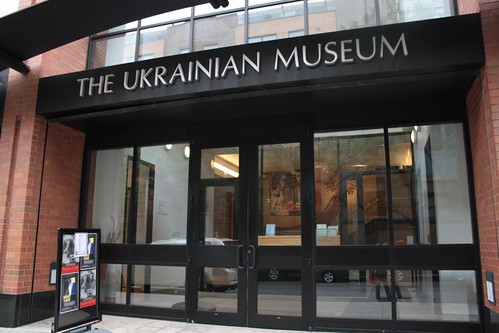Last month, the twentieth anniversary of Ukraine’s declaration of independence from the Soviet Union went largely unnoticed elsewhere in Manhattan; but in a corner of town once known as Little Ukraine, the modest Ukrainian Museum served, as it has since 1976, as a central meeting place for the region’s expats – or as historian Orest Subtelny put it, “a good place to get together to talk.” Last night, Mr. Subtelny, a professor at York University in Toronto, addressed a crowd of about 100 that had gathered to hear him discuss the country’s uncertain future. The event helped launch the museum’s fall season.
The Ukrainian Museum’s modern brick and glass facade is something of a surprise on East Sixth Street, which is otherwise dominated by the imposing St. George Ukrainian Catholic School. The museum was originally located a few blocks north, but moved to its current space, built entirely through donor contributions, six years ago.
A core of just four full-time and four part-time staffers, most of whom have been with the museum since its founding, curate and support three floors of rotating exhibits, as well as a seasonal schedule of courses and workshops. Embroidery classes started this past weekend, with beading classes beginning Oct. 1st., and December will bring Christmas-themed classes in tree-ornament making and bread baking.
Thirty-five years ago, museum director Maria Shust was finishing up graduate school at the University of Pennsylvania when she heard the Ukrainian National Women’s League was trying to open the first museum devoted solely to Ukrainian art in the United States. Ms. Shust, who has aspirations of being an artist, or perhaps teaching art, immediately signed on to the project.
“I always thought that we should show Ukrainian art and culture at the professional level of other cultures,” Ms. Shust said. “I’ve been here ever since.”
The Women’s League’s collection at the time consisted of about 700 items, many of them left over from the Ukrainian booth at the 1933 World’s Fair in Chicago – a booth that the Soviet Union originally sought to block.
Ukrainians across the country heard about the exhibition and came forward with items to be donated. Today, the collection is the largest of its kind in the U.S., and includes over 8,000 folk art pieces, over 2,000 fine art works and more than 30,000 archival items documenting the life and legacy of the Ukrainian people.
Currently on display in the main gallery is an exhibit entitled “Invitation to a Wedding,” featuring an array of elaborately costumed mannequins and other aspects of what Hanya Krill, the museum’s head of development, called the “key moment in [a bride’s] life.” On October 22, a day-long conference will include performances of traditional wedding songs along with presentations like “Songs Your Mother Should Never Have Taught You: Erotic Symbolism in Ukrainian Folk Songs.”
The second floor is devoted to a retrospective on the works of Sviatoslav Hordynsky, one of the Ukraine’s preeminent modernist artists and cultural activists. The gallery is dominated by a life-sized drawing of Jesus that was the preparatory study for a mosaic in St. Sophia Cathedral in Rome.
In the basement, curator Lubow Wolynetz pulls double duty as the instructor of the eight-week embroidery course, which will run through November. Last week, Ms. Wolynetz presided over a class of nine students, spread out over several tables swathed in fabric samples and colorful skeins of thread.
All skill levels are welcome in Ms. Wolynetx’s class, which starts with a beginning running stitch and advances to the elaborate running stitch as well as intricate cutwork techniques similar to those displayed on the bridal gowns in the wedding exhibit.
Folk art is an essential part of the Ukrainian culture, she explained, and besides, it’s fun.
“Crafts are becoming popular,” she said, exhorting a pair of departing young women to do their embroidery homework. “Instead of watching TV, it’s a form of creation.”
The museum’s very existence is a point of pride for the Ukrainian immigrant population, Ms. Krill said, since prior to 1991, these types of folk traditions were being systematically rooted out by the Soviet Union. “Our culture was being eliminated,” Ms. Krill explained.
 Meredith Bennett-Smith Maria Polnyj practices her cross stitch during Lubow Wolynetz’s eight-week folk embroidery course.
Meredith Bennett-Smith Maria Polnyj practices her cross stitch during Lubow Wolynetz’s eight-week folk embroidery course. Two decades later, however, many of those gathered to hear Mr. Subtelny speak had a decidedly jaded view of the revolution’s results: oligarchs plunder the nation’s natural resources while political infighting and accusations of corruption continue to plague the fledgling government.
“I tried to give them a feeling for the past 20 years,” Mr. Subtelny said of what he knew would be a tough crowd: “Most of the audience was programmed to be negative.”
“Somebody’s got to fight the oligarchs,” Mr. Subtelny said. “They’re more powerful now in the Ukraine than even in Russia. The middle class isn’t going anywhere — and it will challenge the oligarchs. It will demand more rule of law.”
Over wine and Ukrainian hors d’oeuvres, Mr. Subtelny was mobbed by attendees eager to continue the political discussion.





